20+ exciting facts about Bihar's famous folk dance
By Srivatsa sai Krishna |
Date 29-08-2024

Table of Contents
Admissions Open for
Discover Bihar's Rich Folk Dance Heritage: History, Importance, and Uniqueness
Bihar is a treasure of East Indian culture and traditions. The famous dances of Bihar have something for everyone in this diversification of heritage reflected throughout festivals and celebrations, and so the rich legacy of the state remains unchanged while living through the stories told by different folk dance forms of Bihar. Our main aim is to keep this folk tradition alive and spread the word about it so that kids can learn about the state's history and culture. Bihar traditional folk dances are an important part of our rich cultural heritage, so we work hard to keep them alive and promote them.
In this blog, let's talk about what the folk dances of Bihar are, their significance, and what makes them truly special.
A mesmerizing dance show by young stars
Watch the talented young kids of Orchids shine on stage with a captivating dance performance!
What is Folk Dance?
Folk dances are public dances that are usually performed in groups and are preserved by local people. These dances not only look beautiful but also tell deep stories about the people who dance them, their beliefs, and their way of life. Folk dances from Bihar represent the people's way of celebrating life and telling interesting stories.
Now, Let's look at some of the famous folk dances of Bihar, what makes them special, and the stories they tell. Here are some of the names of Bihar folk dances, along with some interesting facts about them
Bidesia Dance
Origins and History
- Bidesia (in Hindi: बिदेसिया नृत्य), unlike other folk dances that have their origins in historical traditions, originated in the 20th century, representing relatively recent beginnings during a time when, for the most part, the general populace was not acquainted with drama and theater. The combination of dance, music, and narration results in a dynamic style of musical theater that is characterized by its bright nature.
- This folk dance was created by Bhikhari Thakur, who was a barber by trade but followed his love for acting and theater, which was against the rules of his time. Even though he was having trouble with money, he was determined to follow his dreams.
- Thakur wrote the Bhojpuri play "Bidesiya" (also called "Bahara Bahar") with ideas that were meant to make society better. His hard work eventually changed the course of Bhojpuri folk theater.
- Bidesia Dance is a popular genre of dance-drama that deals with deep themes such as tradition vs. modernity, rural vs. urban lifestyles, and class disparities.
What does Bidesiya's performance look like
- Launda Naach is one of the main signature elements of Bidesia. Men wear feminine dresses and do elegant dances in weddings and other celebrations.
- In Bidesia, this dance style combines cultural heritage with vibrant entertainment, making it a cherished tradition.In some performances, both men and women participate, while in others, only men participate and play both male and female characters. The male character wears long hair wigs to act like a woman.
- The plays focus on very realistic issues such as poverty, women's struggles in their households, and daily emotional battles, with Biraha songs that very vividly portray the hardships of women left behind by their husbands, revealing societal topics rarely discussed openly.
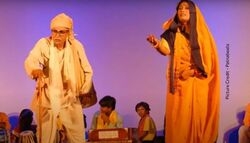
Performers performing Bidesia
Music and Instruments
The musical instruments used are majira or jhanj, dholak, khanjiri, nagara and harmonium played by feet.
Majira/Jhanj:
- A majira is known by many people and can be called manjira; it's one of the Indian percussion instruments that comprises two little cymbals for striking the sound produced, thereby generating a high-pitch
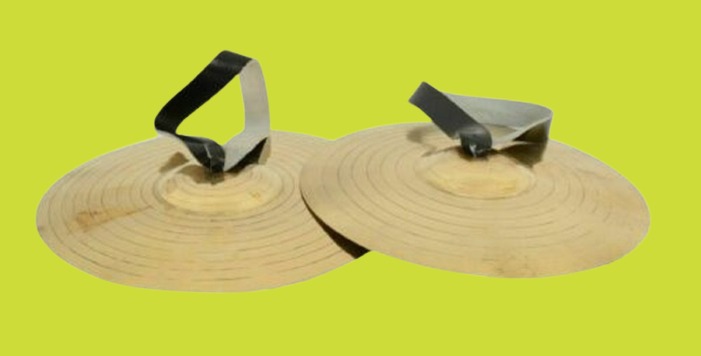
Instrument in Bidesia: Majira( also Known as Manjira)
Khanjiri:
- The kanjira, khanjira, khanjiri or ganjira is a Indian frame drum belonging to the tambourine family. It has been employed as a folk and bhajan instrument in the Indian subcontinent for many years.
- Normally, without tuning, it has a very high-pitched sound. To get a good bass sound, the performer reduces the tension of the drumhead by sprinkling water on the inside of the instrument.
- This process may have to be repeated during a concert to maintain a good sound.
Nagara:
- The nagara is a percussion instrument used in India that is typically made of wood, iron, metal, and leather.
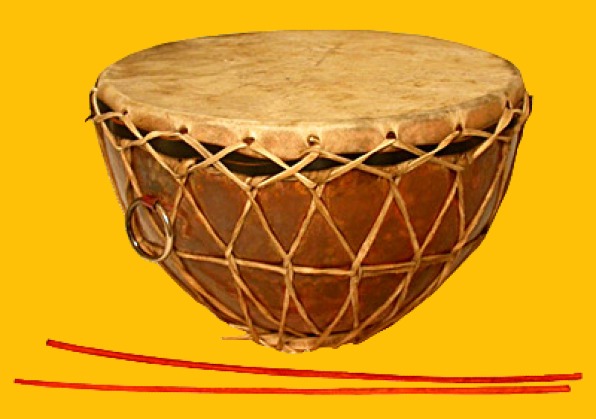
Instrument in Bidesia: Nagara
Significance to children:
- Cultural Gateway: Children learn about Indian folk traditions through Bidesia's interesting mix of dance, music, and stories. This makes learning about culture fun and active.
- Inspiration from Bhikhari Thakur: Thakur's story of going after his dreams despite what society thought was right teaches kids how to be strong and follow their dreams.
- Lessons in Empathy: Heartfelt Biraha songs and realistic themes like poverty, women's struggles, and emotional battles help kids understand and relate to problems that people face in society.
- Respect for Artistic Expression: The Launda Naach style showcases creativity and cultural diversity, teaching kids to appreciate art beyond gender norms. Through our programs we also encourage children to develop these values in a fun and meaningful way through engaging activities just like Launda Naach.
- Bidesia combines lively performances with important lessons so kids can have fun while learning values like getting along with others, being flexible, and being aware of their surroundings.
Jat-Jatin Dance
Origins and History
- The Jat-Jatin (in Hindi: जात-जटिन नृत्य) dance originates from Bihar and holds a prominent place in the state’s cultural traditions, especially in the Mithila and Koshi regions.
- This folk dance is based on the tragic love story of Jat and Jatin, a couple separated by socio-economic challenges, adding emotional depth to their performances.
- Over time, the dance has become a powerful artistic expression, reflected the struggles and emotions of the people while preserving Bihar’s rich heritage.
What does Jat-Jatin performance look like
- Jat-Jatin is traditionally performed by young women and housewives under the moonlight during the monsoon season, often from midnight until morning, creating an enchanting ambiance.
- The dance narrates the poignant love story of Jat and Jatin, while also addressing societal issues like poverty, natural disasters, love, and arguments between couples.
- The dance involves simple yet delicate body movements, with performers taking four steps forward and back in lively and rhythmic patterns.
- Accompanied by the beats of Dadra, Teevta, and Kerwa rhythms, the dance maintains a lively and vigorous tempo with beautiful limb movements and fluid coordination.
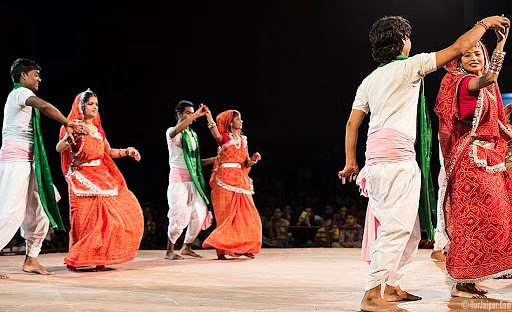
Jat-Jatin Performance(Source:2)
Music and Instruments
Music
Dadra
- Dadra’s light and melodic 3/4 rhythm is perfect for kids, as it accompanies genres like dhun and ghazal, making classical music fun and engaging.
- Parents can use Dadra to introduce their children to the beauty of rhythm and melody, fostering an early appreciation for Indian classical traditions.
Kerwa
- Keharwa is an 8-beat pattern used in ragas. It has eight beats in two equal divisions (vibhag).
Instrument
- Jat-Jatin is a lively dance that is done in a circle by men and women, showing off their strong energy and coordinated movements.
- To the beats of traditional instruments like the dhol, shehnai, and tabla, the dancers do complicated footwork and hand movements that make the room feel exciting.
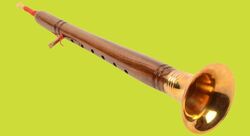
Important Instrument of Jat-Jatin: Shehnai
Significance to children:
- By telling the touching story of Jat and Jatin, the dance introduces children to Bihar's traditions and gives them a significant opportunity to learn about their heritage through art.
- The performances' depictions of love, hardship, and social issues make kids think deeply about their feelings and learn to care about others.
- People who are new to Indian classical rhythms will find the lively beats of Dadra and Kerwa very interesting. The rhythm of the music keeps students interested, and as they play, they gradually get better at timing and melody. Our music programs are meant to help kids develop these skills while also encouraging their creativity and love of music.
- The lively dance steps and formations help kids get exercise and work together, which helps them make friends and celebrate cultural unity.
Jumari Dance
People in the Indian state of Bihar are known for the Jumari dance (in Hindi: जुमारी नृत्य). The dance looks a lot like "Garba" performed in Gujarat.
Origins and History
· The Mithilanchal region of Bihar is the place where the Jumari dance first appeared.
What does Jhumari's performance look like
- Jumari is a cultural practice that is only carried out by married women. It is a sign of good fortune and emphasizes the role that married women play in rituals. Additionally, it is an enriching cultural tradition that can be shared with children.
- Under a moonlit sky that is clear and clear, the dance is performed during the month of Kartik, which is between October and November. This creates a magical atmosphere that highlights the beauty of nature and the connection to traditions.
- Dancers stand in a row, holding hands, swaying, clapping, and singing couplets while occasionally adding timed jumps, creating an energetic and joyful spectacle.
- Children are taught how art and music can be used to express emotions and bring communities together through the practice of Jumari dance, which celebrates happiness and the changing of the seasons.
- The dance, which is performed to lovely folk lyrics such as "Kartik Mas na Aakashey Badari," is a great way to introduce children to traditional music that reflects the cultural diversity of Mithilanchal.
- A visual treat that parents can use to teach their children about the beauty of Indian attire and artistry is provided by the dancers, who are dressed in vibrant outfits and traditional jewellery.
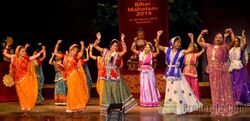
Jhumari Dance by Native People(source:3)
Music and Instruments
The Jhumari dance uses a number of musical instruments which produce a melodious. These instruments are:
- Mandar: A hand-played drum that produces deep, rhythmic sounds.
- Dhol: A two-headed drum played with sticks, setting a lively beat.
- Nagara: A large kettle drum adds dramatic depth to the music.
- Bansuri: A bamboo flute with soft, melodic tones that enhance the overall harmony.
Significance to children:
- Children can learn how to work together and stay in sync with others by watching the Jumari dance and imitating the way people hold hands and move together. This helps them develop their teamwork and collaboration skills.
- Kids can learn about the meaning of seasonal changes in Indian culture by learning about the link between Jumari and the Kartik month. This helps them understand how culture and nature are connected.
- Kids can learn to appreciate Indian craftsmanship and cultural heritage by watching dancers wear bright traditional clothes and jewellery. This can also spark their interest in art and design, encouraging creativity and self-expression. Our art and design programs provide the perfect platform for students to explore their talents and develop their skills.
Kajari Dance
Origins and History
It is considered to be one of the most important dance styles that originated in the Bhojpuri region. In Mirzapur, Kajari (in Hindi: कजरी नृत्य) is a well-known dance.
What does kajari performance look like
- Kajari dancer wears a tight choli with Ghagra that flares out and hits at the ankles. Heavy jewelry like necklaces, bracelets, earrings, and bangles finish off the look, as do dupattas that are spread beautifully over the shoulders and head.
- Kajari dance moves are a lot like Kathak dance moves; they combine traditional dance styles with graceful story-telling techniques.
- Kajari dance is done to the music of Jhula, and the lyrics often praise nature, feelings, and the beauty of the monsoon season. This makes the performance very emotional.
- It can be seen on stage as a dance show or sung by women on monsoon evenings. The latter is called Dhunmuniya and captures the spirit of the season's celebrations.
- The word "Kajari" comes from the word "Kajra", which means "kohl". This name represents the beauty and depth of this semi-classical singing style, which gives the dance a soulful quality.

Performers performing Kajari Dance(Source:4)
Significance to children:
- Children can learn about the cultural meaning of traditional clothing and develop a sense for beauty by watching Kajari dancers wear their colorful ghagra, heavy jewelry, and graceful dupattas.
- Kajari teaches kids how to use dance to express their feelings and stories through graceful storytelling and Kathak-inspired movements. This helps them be more creative.
- Kajari's poetic themes, which honor nature, the monsoons, and feelings, are a lovely way for kids to connect with nature and understand how it affects art and culture.
- Children learn about semi-classical Indian melodies through Kajari, which is danced to Jhula music. This helps them develop an ear for soulful music and understand its role in traditional celebrations.
Sohar Dance
Sohar-Khilona (in Hindi: सोहर नृत्य) is a dance that is done as a ceremony to celebrate the birth of a child in a family. It is a part of many traditional ceremonies across the country. To celebrate the birth of a child in Bihar, people sing the song Sohar.
Origins and History
Sohar is Sung in Bihar when the baby is born. The women often say that the child is like the birth of God Ram or God Krishna, which shows where it came from.
What does Sohar performance look like
- People dance sohar in circles and pairs, and their graceful and lively movements show that they are happy and celebrating.
- Folk songs and music from the area are played along with the dance. The rhythm and melody of the music add to the emotional and cultural depth of the performance.
- The dance gives off a happy vibe, and the movements show how happy and excited everyone is attending and performing.
- Sohar is a lively way to express heritage that connects people to their cultural roots and traditions through music, dance, and stories.
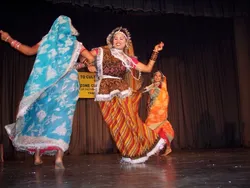
Famous Sohar Dance(source:5)
How to Learn and Enjoy Folk Dance of Bihar
Excellent.! You by now know a few famous folk dances of Bihar. You must be wondering how to learn and enjoy doing these dance forms. So, let us look for ways to have an enormous amount of fun:
- Participate in a Dance Workshop: Most cultural centers and dance schools periodically offer workshops where participants are taught steps and techniques of the folk dance of Bihar.
- Attend cultural festivals: Do develop interest in the different cultural festivals going on near you; you are definitely going to stumble upon some live performances of the folk dances of Bihar. This shall really turn out to be quite a form of exposure as you actually get to see these dances in action.
- Watch Online Videos: You can find loads of videos on the web showing folk dances of Bihar. This may probably give you a good understanding of the dance forms and motivate you to try yourself.
- Participation in School Events: If your school organizes any cultural events or any kind of performances, participate in a folk dance of Bihar. You are going to have fun sharing your love for the dance in front of your friends and family.
A Eye-catching dance show by young stars
As we rethink dance, you'll find movement, self-expression, and new ideas. Step into a world where each step counts
Last Step
It is proper to say that the folk dances of Bihar are an inherent and vibrant part of its cultural heritage. Each form of dance conveys a different story that has been told with regard to being passed through generations by different traditions instilled into those who performed it. Be it the energetic performance of Chhau Dance, making its mark, or the soulful rhythms in Bhawaiya Dance—each Bihar folk dance epitomizes a rich value sewn in the culture of this state.
This way, the very next time you hear about the famous folk dances of Bihar or even come across a Bihar folk dance name, remember that what you are witnessing is something extremely beautiful that has been passed down through generations. Now, whether you are going to watch it or just learn the steps or anything, Bihar folk dances are sure to fill your life with rejoicement and excitement.
Happy dancing!
FAQs
1. How many folk dances are there in Bihar?
There are 14 different kinds of folk dances in Bihar, which show how culturally rich the state is. 5 of them stand out as being very well-known and praised for their captivating performances across many regions. The other remaining few dances are less well known outside of native communities, but they are very important to their cultures because they keep alive traditions and stories that are unique to their origins.
2. When is kajari dance performed in Bihar?
Kajari dance is traditionally done to welcome the monsoon season, which represents the happiness and relief that come with rain after a hot summer. This dance is an artistic way to show appreciation for nature and the new life and wealth that the rain brings. Kajari is a beloved holiday tradition because it brings out feelings of hope, desire, happiness and connection to nature through its lively movements and poetic themes.
3. How many different categories can you put Bihar's folk dance into?
Bihar's folk dance culture can be broken down into three groups. At first, the dance was shown along with a reading of poetry. The second stream is made up of tribal people who care more about the earth. Their dances have been greatly affected by indigenous development. The third stream flows through the rest of south Bihar.
Liked what you read? Then, kindly share this blog with your friends who are interested in the “Folk Dances of Bihar”
Panthi Dance: Explore the origins of Panthi dance, uncovering its rich historical roots and cultural significance.
Folk Dance of Chhattisgarh: Uncover the energetic folk dances of Chhattisgarh, celebrating the area's cultural depth through its traditional dance forms.
History of Folk Dances in India: Learn about the different folk dances in India and their history through our latest blog.
Difference Between Folk Dance and Classical Dance: Get to know about the differences between folk dance and classical dance through our blog.
Frequently Asked Questions
There are 14 different kinds of folk dances in Bihar, which show how culturally rich the state is. 5 of them stand out as being very well-known and praised for their captivating performances across many regions. The other remaining few dances are less well known outside of native communities, but they are very important to their cultures because they keep alive traditions and stories that are unique to their origins.
Kajari dance is traditionally done to welcome the monsoon season, which represents the happiness and relief that come with rain after a hot summer. This dance is an artistic way to show appreciation for nature and the new life and wealth that the rain brings. Kajari is a beloved holiday tradition because it brings out feelings of hope, desire, happiness and connection to nature through its lively movements and poetic themes.
Bihar's folk dance culture can be broken down into three groups. At first, the dance was shown along with a reading of poetry. The second stream is made up of tribal people who care more about the earth. Their dances have been greatly affected by indigenous development. The third stream flows through the rest of south Bihar.
CBSE Schools In Popular Cities
- CBSE Schools in Bangalore
- CBSE Schools in Mumbai
- CBSE Schools in Pune
- CBSE Schools in Hyderabad
- CBSE Schools in Chennai
- CBSE Schools in Gurgaon
- CBSE Schools in Kolkata
- CBSE Schools in Indore
- CBSE Schools in Sonipat
- CBSE Schools in Delhi
- CBSE Schools in Rohtak
- CBSE Schools in Bhopal
- CBSE Schools in Aurangabad
- CBSE Schools in Jabalpur
- CBSE Schools in Jaipur
- CBSE Schools in Jodhpur
- CBSE Schools in Nagpur
- CBSE Schools in Ahmednagar
- CBSE School In Tumkur

Call Us to know more about Orchids
Swipe Up

.jpg&w=1920&q=80)














